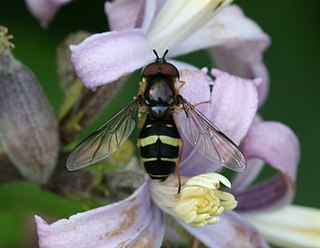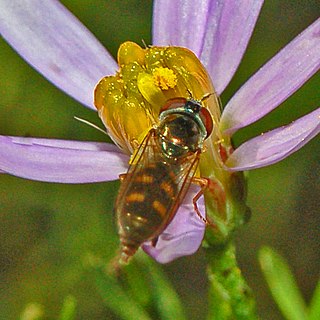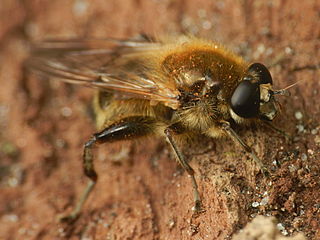
Hover flies, also called flower flies or syrphid flies, make up the insect family Syrphidae. As their common name suggests, they are often seen hovering or nectaring at flowers; the adults of many species feed mainly on nectar and pollen, while the larvae (maggots) eat a wide range of foods. In some species, the larvae are saprotrophs, eating decaying plant and animal matter in the soil or in ponds and streams. In other species, the larvae are insectivores and prey on aphids, thrips, and other plant-sucking insects.

Eristalis arbustorum, the European drone fly, is an abundant Northern Hemisphere species of syrphid fly, originally officially described by Linnaeus in 1758 as Musca arbustorum. The name "drone fly" is related to its similar appearance to the drone of the honeybee. Hoverflies get their names from the ability to remain nearly motionless while in flight. The adults are also known as flower flies as they are commonly found on and around flowers from which they get both energy-giving nectar and protein rich pollen. The larvae are aquatic filter-feeders of the long-tailed type.

Xylota segnis, The Brown-toed Forest Fly, is a common species of hoverfly.

Platycheirus clypeatus is a species of hoverfly. It is found across the Palearctic and in the Nearctic. The larvae feed on aphids. Adults are usually found on the edges of woodland or scrub, heath or along hedgerows where they visit a wide range of flowers.

Dasysyrphus is a genus of hover flies with 50 identified species distributed worldwide. While the genus is relatively easy to identify, genera key the differences between species have a more narrow range of variations. Therefore, identification of species by images of specimens alone should be made with care.

Dasysyrphus tricinctus is a European species of hoverfly in the genus Dasysyrphus, a member of the family Syrphidae. It is found across Europe, although reported in highest density from the British Isles and Scandinavia. While not uncommon it is generally only seen in modest numbers, typically in lowland woods with peak numbers in late May and early June and again in late August and early September.

Platycheirus peltatus is a Palearctic species of hoverfly.

Platycheirus scutatus is a very common species of hoverfly. It is a Holarctic species.

Baccha elongata is a species of hoverfly in the genus Baccha.

Chalcosyrphus is a genus of hoverflies in the subfamily Eristalinae. Many species exhibit some degree of mimicry of various sawflies and other hymenopterans and are often brightly coloured or metallic in hue. The adults are similar in structure and behavior to the related genus Xylota but differ in larval morphology. They can be found throughout Europe, Asia, and North America and seem to prefer damper, boggy habitats. The larvae are saproxylic feeders in rotten wood in these habitats.

Platycheirus manicatus is a species of hoverfly. It is found across the Palearctic and in Alaska.

Anasimyia is a genus of wetland hoverflies with aquatic larvae. The genus was formerly regarded as a subgenus of the similar Lejops, and recently elevated to genus.

Heringia or the Smoothleg fly is a genus of hoverflies, from the family Syrphidae, in the order Diptera. The species are distributed in North America and Europe Larvae are predatory upon Schizoneura aphids on Ulmus and Pemphigus aphids on Populus, Dreyjusia piceae on Abies and Eriosoma lanigerum on Malus.

Brachypalpus is a genus of hoverflies, from the family Syrphidae, in the order Diptera. The head is triangular and produced well forwards and somewhat downwards. The thorax and abdomen with pile often rather long. The hind femur is swollen and with an obtuse spur apically and ventrally. The hind trochanters of male is spurred.
The larvae are of the rat-tailed type feeding on decaying sap under tree bark. Larvae live in decaying trees and logs. Larva and pupa have been described by Malloch.

Fagisyrphus cinctus is a European species of hoverfly. This species has a muddled taxonomic history. Older authors treated it as a member of the genus Melangyna, and later sources in Meligramma, but the most recent sources recognize it as the sole species in its own monotypic genus, Fagisyrphus.

Parasyrphus vittiger is a species of hoverfly, from the family Syrphidae, in the order Diptera.

Lejops vittatus is a European species of hoverfly.

Platycheirus ambiguus is a small widespread species of hoverfly found across the Palearctic from Ireland to Japan. A spring species found in flight in April and May, it visits spring-flowering trees and shrubs; e.g., Prunus spinosa in deciduous woodland and scrub.
Melangyna arctica is a Holarctic species of hoverfly.

Meligramma guttatum is a Holarctic species of hoverfly.



















